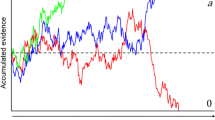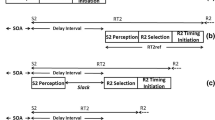Summary
The kinematics of leftward and rightward movements are different. The question is raised whether these differences in both arms are best accounted for in terms of the flexion-extension dimension or the leftward-rightward dimension. In a simple step-tracking experiment the acceleration-time curves of fast flexions and extensions of the left and of the right elbow joint in a horizontal plane were recorded. The durations of individual segments of the acceleration curves are best predicted by spatial direction: that is, the differences between leftward and rightward movements are either both positive or both negative in both arms. This holds only for the first part of the movement until maximum deceleration is reached. From then on the timing is best predicted by the flexion-extension dimension. This is taken as evidence for a two-process theory of motor control according to which a central process is first in command and a lower-level, muscle-related process then takes over. Although a change which corresponds to the one observed in the time variables is not seen in the maxima of the acceleration curves, this seeming disparity can be reconciled with a two-process theory.
Similar content being viewed by others
References
Adams JA (1971) A closed-loop theory of motor learning. J Mot Behav 3:111–150
Adams JA (1976) Issues for a closed-loop theory of motor learning. In: Stelmach GE (ed) Motor control: Issues and trends. Academic Press, New York
Asratyan DG, Fel'dman AG (1965) Functional tuning of the nervous system with control of movement or maintenance of a steady posture. I. Mechanographic analysis of the work on a joint on execution of a postural task. Biophys 10:925–935
Bizzi E (1980) Central and peripheral mechanisms in motor control. In: Stelmach GE, Requin J (eds) Tutorials in motor behavior. North-Holland, Amsterdam
Bizzi E, Polit A (1979) Characteristics of motor programs underlying visually evoked movements. In: Talbott RE, Humphrey DR (eds) Posture and movement. Raven Press, New York
Bouisset S, Lestienne F (1974) The organization of a simple voluntary movement as analysed from its kinematic properties. Brain Res 71:451–457
Brooks VB (1979) Motor programs revisited. In: Talbott RE, Humphrey DR (eds) Posture and movement, Raven Press, New York
Christina RW (1970) Minimum visual feedback processing time for amendment of an incorrect movement. Percept Mot Skills 31:991–994
Cooke JD (1980) The organization of simple, skilled movements. In: Stelmach GE, Requin J (eds) Tutorials in motor behavior. North-Holland, Amsterdam
Craik KJW (1947) Theory of the human operator in control systems. I. The operator as an engineering system. Brit J Psychol 38:56–61
Derwort A (1938) Untersuchungen über den Zeitverlauf figurierter Bewegungen beim Menschen. Pflüg Arch ges Physiol 240:661–675
Ells JG (1973) Analysis of temporal and attentional aspects of movement control. J Exp Psychol 99:10–21
Fel'dman AG (1966a) Functional tuning of the nervous system with control of movement or maintenance of a steady posture. II. Controllable parameters of the muscle. Biophys 11:565–578
Fel'dman AG (1966b) Functional tuning of the nervous system with control of movement or maintenance of a steady posture. III. Mechanographic analysis of the execution by man of the simplest motor task. Biophys 11:766–775
Fitts PM (1954) The information capacity of the human motor system in controlling the amplitude of movement. J Exp Psychol 47:381–391
Fitts PM, Peterson JR (1964) Information capacity of discrete motor responses. J Exp Psychol 67:103–112
Ghez C (1979) Contributions of central programs to rapid limb movement in the cat. In: Asanuma H, Wilson VJ (eds) Integration in the nervous system. Igaku-Shoin, Tokio
Glencross DJ (1977) Control of skilled movements. Psychol Bull 84:14–29
Granit R (1970) The basis of motor control. Academic Press, New York
Grillner S (1972) The role of muscle stiffness in meeting the changing postural and locomotor requirements for force development by the ankle extensors. Acta Physiol Scand 86:92–108
Hacker W (1967) Grundlagen der Regulation von Arbeitsbewegungen. Probl Ergebn Psychol Beiheft 1
Hacker W (1974) Anforderungen an Regulation und Zeitbedarf bei geführten Bewegungen: Zur Gültigkeit des Derwort-von Weizsäcker'schen Gesetzes der konstanten Figurzeit. Z Psychol 182:307–337
Hallett M, Shahani BT, Young RR (1975) EMG analysis of stereotyped voluntary movements in man. J Neurol Neurosurg Psychiat 38:1154–1162
Henry FM, Rogers DE (1960) Increased response latency for complicated movements and a ‘memory-drum’ theory of neuromotor reaction. Res Quart 31:448–458
Heuer H (1979) Über Bewegungsprogramme bei willkürlichen Bewegungen. Berichte aus dem Fachbereich Psychologie der Philipps-Universität Marburg/Lahn, Nr 76
Heuer H (1981) Über Beanspruchungsänderungen im Verlauf schneller gezielter Bewegungen. Z exp angew Psychol 28:255–280
Holst Ev (1937) Vom Wesen der Ordnung im Zentralnervensystem. Naturwissensch 25:641–647
Holst Ev (1939) Die relative Koordination als Phänomen und als Methode zentralnervöser Funktionsanalyse. Ergebn Physiol 42:228–306
Houk JC (1979) Regulation of stiffness by skeletomotor reflexes. Ann Rev Physiol, 41:99–114
Houk J, Henneman F (1967) Feedback control of skeletal muscles. Brain Res 5:433–451
Jagacinski RJ, Repperger DW, Moran MS, Ward SL, Glass B (1980) Fitts's law and the microstructure of rapid discrete movements. J Exp Psychol Hum Percept Perf 6:309–320
Kalveram KT (1975) Das Marburger System. Berichte aus dem Fachbereich Psychologie der Philipps-Universität Marburg/Lahn, Nr 44
Keele SW (1968) Movement control in skilled motor performance. Psychol Bull 70:387–403
Keele SW, Posner MI (1968) Processing of visual feedback in rapid movements. J Exp Psychol 77:155–158
Kelso JAS, Holt KG, Kugler PN, Turvey MT (1980) On the concept of coordinative structures as dissipative structures. II. Empirical lines of convergence. In: Stelmach GE, Requin J (eds) Tutorials in motor behavior, North-Holland, Amsterdam
Kelso JAS, Southard DL, Goodman D (1979) On the coordination of two-handed movements. J Exp Psychol Hum Percept Perf 5:229–238
Kelso JAS, Stelmach GE (1976) Central and peripheral mechanisms in motor control. In: Stelmach GE (ed) Motor control: Issues and trends. Academic Press, New York
Kennedy D (1973) Control of motor output. In: Stein RB, Pearson KG, Smith RS, Redford JB (eds) Control of posture and locomotion. Plenum Press, New York
Kern G (1933) Motorische Umreißung optischer Gestalten. Neue Psychol Stud 9:65–104
Klapp ST (1979) Doing two things at once: The role of temporal compatibility. Mem Cognit 7:375–381
Küpfmüller K, Poklekowski P (1956) Der Regelmechanismus willkürlicher Bewegungen. Z Naturforsch 11b:1–7
Langolf DG, Chaffin DB, Foulke JA (1976) An investigation of Fitts's law using a wide range of movement amplitudes. J Mot Behav 8:113–128
Lashley KS (1951) The problem of serial order in behavior. In: Jeffress LA (ed) Cerebral mechanisms in behavior. Wiley, New York
Lestienne F (1979) Effects of inertial load and velocity on the braking process of voluntary limb movements. Exp Brain Res 35:407–418
Lestienne F, Polit A, Bizzi E (1980) From movement to posture. In: Nadeau CH, Halliwell WR, Newell KM, Roberts GC (eds) Psychology of motor behavior and sport — 1979. Human Kinetics Publishers, Champaign, Ill.
Marteniuk RG, MacKenzie CL (1980) A preliminary theory of two-hand co-ordinated control. In: Stelmach GE, Requin J (eds) Tutorials in motor behavior. North-Holland, Amsterdam
McCormick EJ (1970) Human factors engineering. McGraw-Hill, New York
McLeod P (1980) What can RT tell us about the attentional demands of movement? In: Stelmach GE, Requin J (eds) Tutorials in motor behavior. North-Holland, Amsterdam
Megaw ED (1972) Directional errors and their correction in a discrete tracking task. Ergonomics 15:633–643
Merton PA (1953) Speculations on the servo control of movement. In: Wolstenholme GEW (ed) The spinal cord. Little, Brown. Boston. Mass.
Nichols TR, Houk JC (1976) Improvement in linearity and regulation of stiffness that results from the actions of the stretch reflex. J Neurophysiol 39:119–142
Partridge LD (1967) Intrinsic factors producing inertial compensation in muscle. Biophys J 7:853–863
Polit A, Bizzi F (1979) Characteristics of motor programs underlying arm movements in monkeys. J Neurophysiol 42:183–194
Poulton EC (1966) Tracking behavior. In: Bilodeau EA (ed) Acquisition of skill. Academic Press, New York
Schmidt RA, McGown C (1980) Terminal accuracy for unexpectedly loaded rapid movements: Evidence for a mass-spring mechanism in programming. J Mot Behav 12:149–161
Schmidt RA, Zelaznik HN, Frank JS (1978) Sources of inaccuracy in rapid movement. In: Stelmach GE (ed) Information processing in motor control and learning. Academic Press, New York
Schmidtke H (1960) Über die Struktur willkürlicher Bewegungen. Psychol Beitr 5:428–439
Taylor FV, Birmingham HP (1948) Studies of tracking behavior. II. The acceleration pattern of quick manual corrective responses. J Exp Psychol 38:738–795
Timpe K-P (1968) Ansätze zur Modellierung eingeübter sensomotorischer Prozesse (Das Regelverhalten des Menschen). In: Klix F (ed) Kybernetische Analysen geistiger Prozesse. VEB Deutscher Verlag der Wissenschaften, Berlin
Vallbo AB (1971) Muscle spindle response at the onset of isometric voluntary contractions in man: Time difference between fusimotor and skeletomotor effects. J Physiol 218:405–431
Author information
Authors and Affiliations
Rights and permissions
About this article
Cite this article
Heuer, H. Fast aiming movements with the left and right arm: Evidence for two-process theories of motor control. Psychol. Res 43, 81–96 (1981). https://doi.org/10.1007/BF00309640
Received:
Issue Date:
DOI: https://doi.org/10.1007/BF00309640




